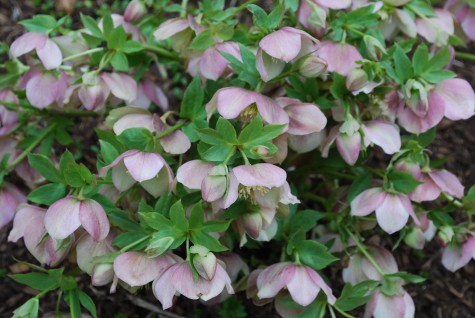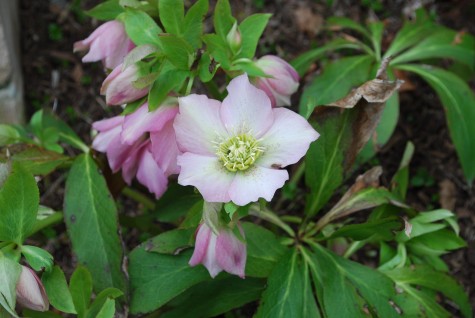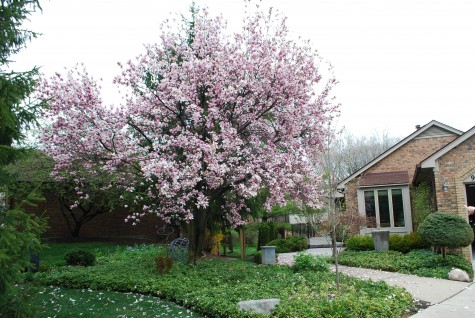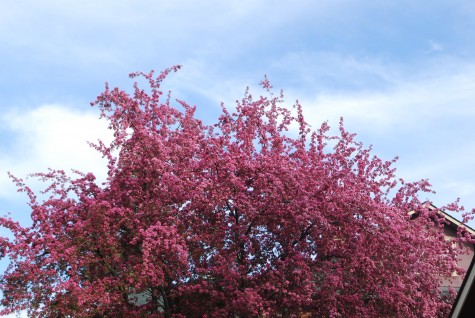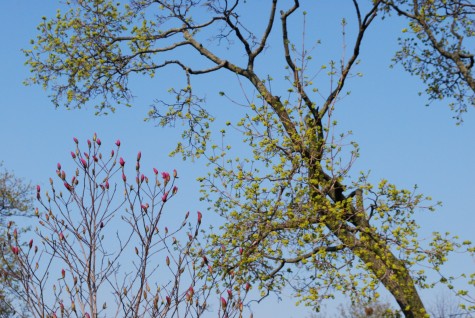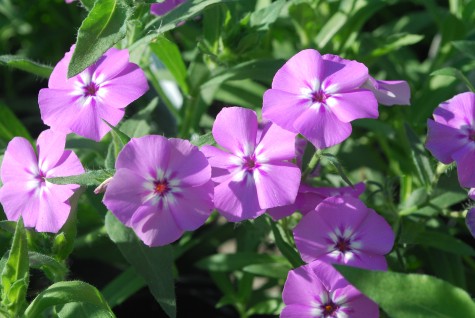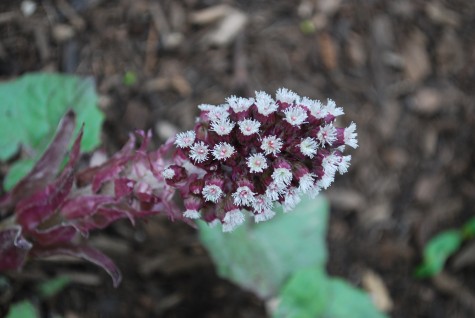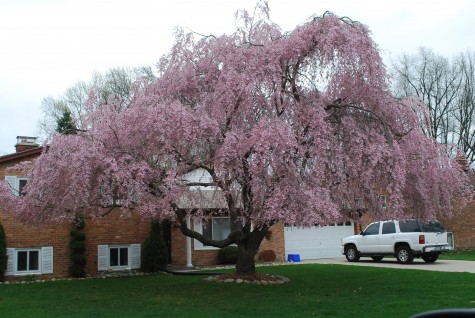Archives for April 2010
At A Glance: Spring Pink
Bad Weather
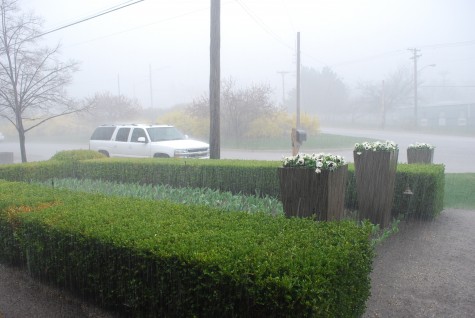 I have been wringing my hands all week over heavy rains, wind and hail that are to be followed by 30 degrees overnight, tonight. I have tulips already budded, Galaxy magnolias showing color and ready to pop, hellebores in full bloom-not to mention my star magnolia. As I write, those fluttery petals are drooping from the cold and wind. A few flowers on my PJM rhododendrons are out-this is very early. The early spring weather has been very warm- warm enough to make me nervous about the possibility of an untoward frost. That possibility is looking really good right now. The maples in the neighborhood just started blooming two days ago. Those masses of tiny chartreuse flowers against a china blue spring sky-one of my favorite spring moments. What will happen?
I have been wringing my hands all week over heavy rains, wind and hail that are to be followed by 30 degrees overnight, tonight. I have tulips already budded, Galaxy magnolias showing color and ready to pop, hellebores in full bloom-not to mention my star magnolia. As I write, those fluttery petals are drooping from the cold and wind. A few flowers on my PJM rhododendrons are out-this is very early. The early spring weather has been very warm- warm enough to make me nervous about the possibility of an untoward frost. That possibility is looking really good right now. The maples in the neighborhood just started blooming two days ago. Those masses of tiny chartreuse flowers against a china blue spring sky-one of my favorite spring moments. What will happen?
I cannot bear to think about the just emerging, dense and soft growth on my magnificent katsura espaliers. They have only been out of their black semi-truck box for two days, after a weeks trip from the West Coast. How will those leaves react to freezing temperatures? I shudder to think. I cannot do a thing about those katsuras, but I can move as much else as possible into the garage. Nature invariably plays hardball with serious gardeners. We people seem to think our extenuating circumstances should count for something, and mitigate the natural course of events. I have had clients who think the weather does not apply to them or their gardens. Sometimes I have to gently remind them sometimes that no one has made me President of the weather. Nature is all about variability; many plants have built in mechanisms to deal with that big fluid situation. Some seeds will not germinate, unless there has been a burn. Some trees have enough stored energy to re-leaf, given an epic disaster. But a hard freeze to new soft growth-this can be unforgiving.
Weather disasters are tough to take-my star magnolia only blooms once every twelve months; I am watching it fade before its time. The wet weather last summer wrecked tomato harvests for many gardeners. Though I am not a vegetable gardener, I was sympathetic. I am intimately acquainted with the sheer exasperation which comes from not being in charge of the weather. I can plan all I want, but being ready to endure what is not part of your best laid plans is a given, should you garden.
Plants are covered with moisture overnight. Frost protection is an effort to keep the moisture on the surface of leaves or buds from freezing. Covering plants before the end of the day helps trap heat-and help keep that moisture liquid. Should that moisture on plant leaves or buds freeze, it will reduce the tissue to black mush; every gardener knows what frost damage looks like. That mush look is chasing me-we spent the day hauling plants inside. Very hard frosts can freeze leaf cells; this damage is the worst.
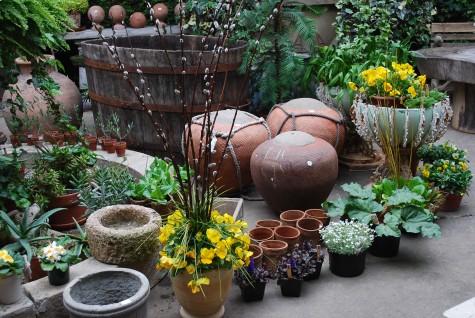 The greenhouse room is stuffed; just about every square inch is loaded with spring plants. I should be happy I have indoor space. After I move past the be grateful thought, I wish I could float frost cover over my gardening world. As that wish is not about to be fulfilled anytime soon, I can only hope for the best.
The greenhouse room is stuffed; just about every square inch is loaded with spring plants. I should be happy I have indoor space. After I move past the be grateful thought, I wish I could float frost cover over my gardening world. As that wish is not about to be fulfilled anytime soon, I can only hope for the best.
 Lots of spring plants are very cold hardy. But once they have become accustomed to warmer weather, and push new soft growth, they are vulnerable to precipitous temperature drops. Gardeners who germinate plants from seeds indoors are bound to the ritual of hardening off. Shocking plants with any abrupt change can make them very mad-or kill them. Though you might think nature invented fall for the great visuals, a long and slow fall cooling period prepares plants for the deep freeze. Should summer ever turn on a dime into winter, there would be terrible losses. The transitional weather we call fall and spring can be brutal for plants and gardeners.
Lots of spring plants are very cold hardy. But once they have become accustomed to warmer weather, and push new soft growth, they are vulnerable to precipitous temperature drops. Gardeners who germinate plants from seeds indoors are bound to the ritual of hardening off. Shocking plants with any abrupt change can make them very mad-or kill them. Though you might think nature invented fall for the great visuals, a long and slow fall cooling period prepares plants for the deep freeze. Should summer ever turn on a dime into winter, there would be terrible losses. The transitional weather we call fall and spring can be brutal for plants and gardeners.
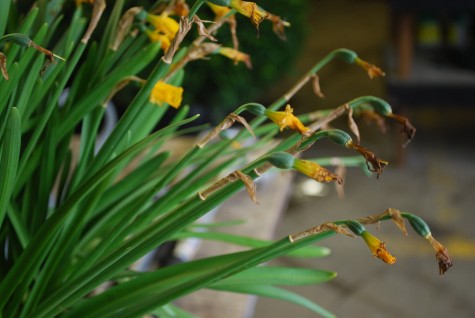
These early mini daffodils closed up shop in last night’s 32 degrees. My crocus came and went so fast, I wondered if I had imagined them blooming. I will not sleep so good, but I will get up and keep gardening.
The 2010 Espaliers

I have been awaiting with great anticipation the delivery of a group of espaliers from the West Coast. Even in photographs, I knew they might be among the most amazing trees I had ever seen. I buy only a small amount of nursery material every year; those plants that have the potential to organize and electrify an entire landscape particularly interest me. A few weeks ago, I did write about these trees, and post pictures of them from the grower. But today was the day I would finally lay eyes on them.
 The pictures did not really prepare me for what came off that semi-truck. I was star struck. They are very large caliper trees, whose years and years of training have produced an entirely unique and compelling living sculpture. The intersection of nature and man can be a disaster, but in this case-breathtaking.
The pictures did not really prepare me for what came off that semi-truck. I was star struck. They are very large caliper trees, whose years and years of training have produced an entirely unique and compelling living sculpture. The intersection of nature and man can be a disaster, but in this case-breathtaking.
 Of great concern to me-the travel. Thousands of miles these trees were trucked- under refrigeration. Spring weather can be unpredictable-a warm journey across the country could cook the emerging foliage. A truck ride is not the smoothest-those of you who travel in trucks regularly know from whence I speak. My eyes were on the rootballs before I even looked at the plants. A broken rootball will kill a tree. These rootballs were solid as a rock; the balling and burlapping the work of a consummate grower. I breathed a big sigh of relief.
Of great concern to me-the travel. Thousands of miles these trees were trucked- under refrigeration. Spring weather can be unpredictable-a warm journey across the country could cook the emerging foliage. A truck ride is not the smoothest-those of you who travel in trucks regularly know from whence I speak. My eyes were on the rootballs before I even looked at the plants. A broken rootball will kill a tree. These rootballs were solid as a rock; the balling and burlapping the work of a consummate grower. I breathed a big sigh of relief.
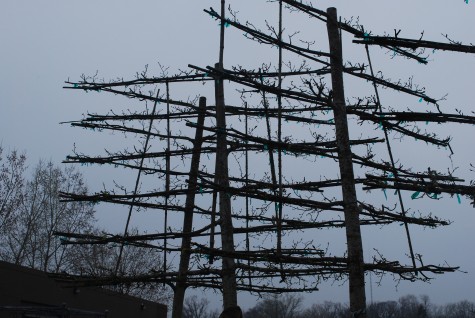 Plan A was to ship the trees via the rail as far as Chicago, and truck the last leg. This plan depended on the grower being able to dig the trees well in advance of any leafing out. Fields too wet from spring rain prevented them from digging the trees early-we had no choice but to go to plan B-a truck coming across the country, carrying trees in the process of throwing leaves. There is worry attached to this plan. A long trucking siege challenges and wears away at trees already stressed from the process of digging, balling, and burlapping. Nursery people understand how much the trucking cost influences the price of a tree. Unless you are buying trees and shrubs grown next door to a nursery, a chunk of the eventual price is very much influenced by the cost of transport. I know of no grower in this country growing espaliers of this caliber, so I shut up, and I paid the freight.
Plan A was to ship the trees via the rail as far as Chicago, and truck the last leg. This plan depended on the grower being able to dig the trees well in advance of any leafing out. Fields too wet from spring rain prevented them from digging the trees early-we had no choice but to go to plan B-a truck coming across the country, carrying trees in the process of throwing leaves. There is worry attached to this plan. A long trucking siege challenges and wears away at trees already stressed from the process of digging, balling, and burlapping. Nursery people understand how much the trucking cost influences the price of a tree. Unless you are buying trees and shrubs grown next door to a nursery, a chunk of the eventual price is very much influenced by the cost of transport. I know of no grower in this country growing espaliers of this caliber, so I shut up, and I paid the freight.
 Seven of the trees are katsuras-Cercidiphyllum Japonicum, for those of you who want to know precisely what tree to which I am referring. A katsura does not have showy blooms-I would describe it as an unusual tree, very architectural in form. The leaves sprout red, grow large, and somewhat heart shaped, and mature with a decidedly blue cast. Mature trees are densely foliated, and sculptural. In this group, I would put the beeches, the dawn redwoods, the weeping Alaskan cedars, the lindens-I am talking green sculpture when I talk katsuras.
Seven of the trees are katsuras-Cercidiphyllum Japonicum, for those of you who want to know precisely what tree to which I am referring. A katsura does not have showy blooms-I would describe it as an unusual tree, very architectural in form. The leaves sprout red, grow large, and somewhat heart shaped, and mature with a decidedly blue cast. Mature trees are densely foliated, and sculptural. In this group, I would put the beeches, the dawn redwoods, the weeping Alaskan cedars, the lindens-I am talking green sculpture when I talk katsuras.
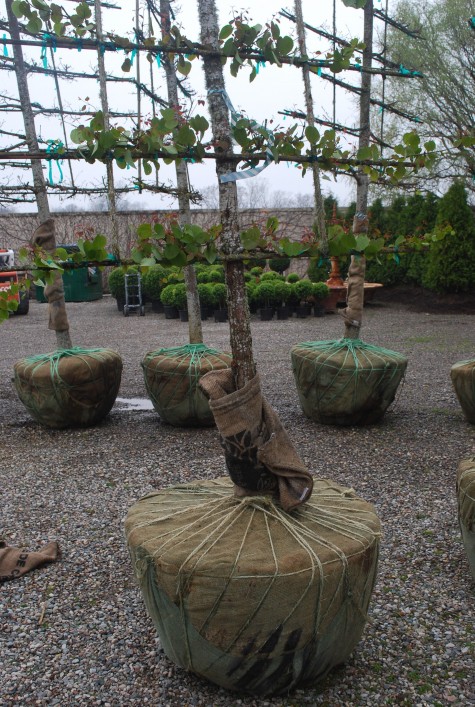 These katsuras have been grown and pruned with strong and precisely spaced lateral branches. What does this mean? In leaf, each tree will provide a green wall every bit of 10 feet tall and ten feet wide that takes up not 24 inches of width, in ground. A living wall of green of astonishing size and very modest footprint-amazing. If beautiful plants have the ability to astonish you, feel free.
These katsuras have been grown and pruned with strong and precisely spaced lateral branches. What does this mean? In leaf, each tree will provide a green wall every bit of 10 feet tall and ten feet wide that takes up not 24 inches of width, in ground. A living wall of green of astonishing size and very modest footprint-amazing. If beautiful plants have the ability to astonish you, feel free.
 How these leaves survived a a week in a black, cold, and irregularly vibrating box-most plants have a huge will to survive. This instinct served these trees well. The katsura group of 7 weathered the storm like troupers. The linden group of 7 are just budded-they had a much easier trip. In my landscape practice, I try very hard to do no harm, to not impose. How nature works is a miraculous event that needs little in the way of suggestions from me. 14 trees of astonishing provenance came my way today. In short, thrilling.
How these leaves survived a a week in a black, cold, and irregularly vibrating box-most plants have a huge will to survive. This instinct served these trees well. The katsura group of 7 weathered the storm like troupers. The linden group of 7 are just budded-they had a much easier trip. In my landscape practice, I try very hard to do no harm, to not impose. How nature works is a miraculous event that needs little in the way of suggestions from me. 14 trees of astonishing provenance came my way today. In short, thrilling.
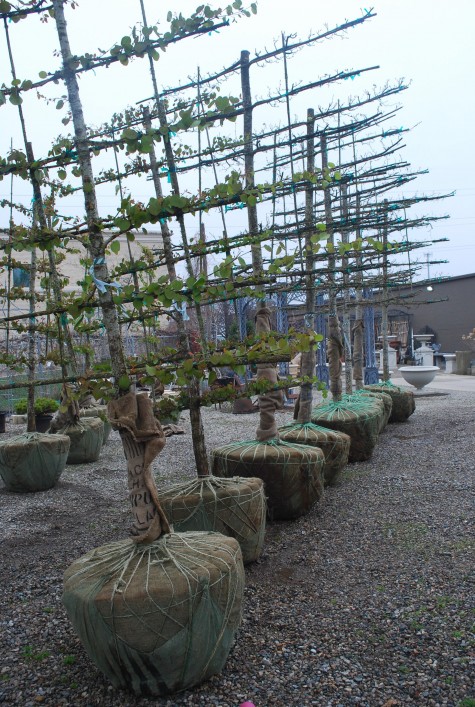 We soaked these trees immediately after delivery, but they had in fact been well prepared for their trip. I sat on 6 randomly selected rootballs today-I could feel the cold, and the damp. The rainy weather and cloudy skies the past few days-a better than good re-entry. I made it my business to go out to see them 4 times today; every gardener understands what it is to be responsible .
We soaked these trees immediately after delivery, but they had in fact been well prepared for their trip. I sat on 6 randomly selected rootballs today-I could feel the cold, and the damp. The rainy weather and cloudy skies the past few days-a better than good re-entry. I made it my business to go out to see them 4 times today; every gardener understands what it is to be responsible .
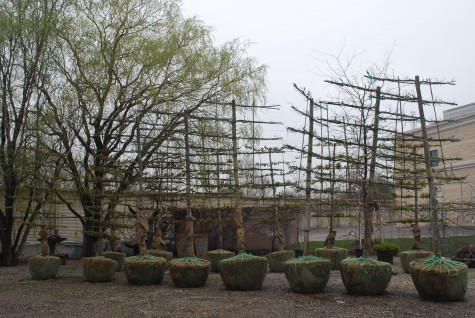
Here is a picture of my group of fourteen espaliers-are they not incredible? Barely leafing, like a crowd of teenagers, I see so much ahead for them. Some time ago I wrote an essay about the provenance of espaliered trees-Palmette Legendre-should you have an interest. I have a big interest in outstanding plants-this drives just about everything I design. These espaliered trees-my only hope for them is that they have thoughtful gardeners in their future.
Evergreen Theatre
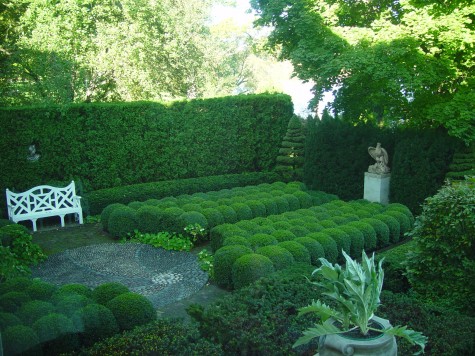 I deliberately chose to follow up yesterday’s post about the pitiful state of my garden with a discussion of evergreens in the landscape. This garden I planted many years ago; it has been maintained with distinction. I will post this picture every so often as long as I live-is this garden not the most beautiful? Evergreens play a lead role in those transitions between the seasons. They shine in the late fall, winter, and early spring in my zone. Were I gardening in Florida or Spain, I would still give plenty of consideration to evergreens-the broadleaf ones in particular. Were I to find myself gardening at the equator, I would not be happy. I have had my seasons too many years to give them up. How to handle the transitions of the seasons-the evergreens do the work. Yesterday’s post was all about dirt and desolation, but in fact my landscape has green structure.
I deliberately chose to follow up yesterday’s post about the pitiful state of my garden with a discussion of evergreens in the landscape. This garden I planted many years ago; it has been maintained with distinction. I will post this picture every so often as long as I live-is this garden not the most beautiful? Evergreens play a lead role in those transitions between the seasons. They shine in the late fall, winter, and early spring in my zone. Were I gardening in Florida or Spain, I would still give plenty of consideration to evergreens-the broadleaf ones in particular. Were I to find myself gardening at the equator, I would not be happy. I have had my seasons too many years to give them up. How to handle the transitions of the seasons-the evergreens do the work. Yesterday’s post was all about dirt and desolation, but in fact my landscape has green structure.
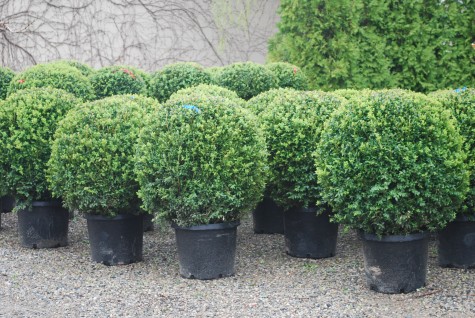 These buxus sempervirens topiary balls arrived from Oregon yesterday. This species could be hardy in ground for four straight mild winters, and then burn and die over the fifth. Why do I buy them? They are incredibly beautiful in pots; I do not fault them for needing to be stored in an unheated garage or building over our winter. This mouthwatering and luscious green sculpture in April-I cannot take my winter weary eyes off these plants. I have a pair that have been in giant French terra cotta pots for some years. They do fine in my unheated and unlit garage-outdoors right now, they focus my attention away from dirt, debris and the otherwise deadly and depressing. Gardeners are a hopeful lot, are they not?
These buxus sempervirens topiary balls arrived from Oregon yesterday. This species could be hardy in ground for four straight mild winters, and then burn and die over the fifth. Why do I buy them? They are incredibly beautiful in pots; I do not fault them for needing to be stored in an unheated garage or building over our winter. This mouthwatering and luscious green sculpture in April-I cannot take my winter weary eyes off these plants. I have a pair that have been in giant French terra cotta pots for some years. They do fine in my unheated and unlit garage-outdoors right now, they focus my attention away from dirt, debris and the otherwise deadly and depressing. Gardeners are a hopeful lot, are they not?
 Boxwood of this size on standard-I never see this form in boxwood hardy in Michigan. It would take so many years to grow to this size, you would need to allocate your child’s college fund to buy one. Buxus sempervirens grows like a weed in mild climates; these came from Oregon. They will flush new growth twice in a growing season. They are an investment-but given our 6 months of garden off season-worth the expense.
Boxwood of this size on standard-I never see this form in boxwood hardy in Michigan. It would take so many years to grow to this size, you would need to allocate your child’s college fund to buy one. Buxus sempervirens grows like a weed in mild climates; these came from Oregon. They will flush new growth twice in a growing season. They are an investment-but given our 6 months of garden off season-worth the expense.
 Evergreen hedges are pedestrian in the summer garden; this arborvitae hedge is the last thing you notice in this picture. They make a solid and quiet green wall onto which a gardener can sculpt their own idea of beautiful. Evergreens do a great job of serenely enclosing spaces. The center of interest in a landscape space can be encouraged, enlivened, made more special, via an evergreen backdrop.
Evergreen hedges are pedestrian in the summer garden; this arborvitae hedge is the last thing you notice in this picture. They make a solid and quiet green wall onto which a gardener can sculpt their own idea of beautiful. Evergreens do a great job of serenely enclosing spaces. The center of interest in a landscape space can be encouraged, enlivened, made more special, via an evergreen backdrop.
 These trimmed topiary evergreens ask for a more starring role. Comfortable in the lights-yes, they are. Can they organize a space, provide star power, hold their own-no doubt.
These trimmed topiary evergreens ask for a more starring role. Comfortable in the lights-yes, they are. Can they organize a space, provide star power, hold their own-no doubt.
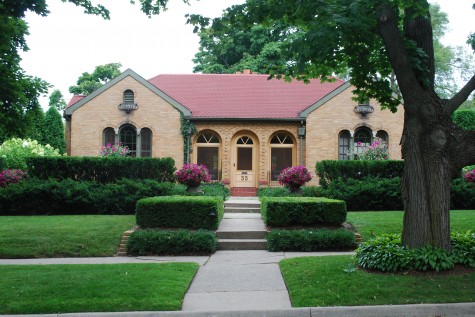 Though I published pictures yesterday of my pitiful rose and perennial gardens, and what the corgis have rent asunder, my landscape is by and large defined by its evergreens. Much behind the scenes workhorses in July, they are the star of my show in April. All of my landscape spaces are structured with plantings of those plants that stay green all year long. My public presentation looks presentable all year long. Behind these yew hedges I have perennials and pots-none of which look like anything right now. Better that I deal with what does not look great in April, than my neighbors. I do feel it is my responsibility to present a dressy and neat appearance every month of the year to others in the neighborhood. This is good manners. Those people that plant vegetable gardens in their front yards-I am happy to not be living next door to them; that would be tough for me. The beauty of a garden is year round, given committment and imagination. The neighbors aside, evergreens provide structure, privacy and peace. They break the fierce fall and spring winds-many of your other plants might prosper from the big brother or older sister an evergreen hedge might provide. Those six months I cannot garden in Michigan-my evergreens tide me over.
Though I published pictures yesterday of my pitiful rose and perennial gardens, and what the corgis have rent asunder, my landscape is by and large defined by its evergreens. Much behind the scenes workhorses in July, they are the star of my show in April. All of my landscape spaces are structured with plantings of those plants that stay green all year long. My public presentation looks presentable all year long. Behind these yew hedges I have perennials and pots-none of which look like anything right now. Better that I deal with what does not look great in April, than my neighbors. I do feel it is my responsibility to present a dressy and neat appearance every month of the year to others in the neighborhood. This is good manners. Those people that plant vegetable gardens in their front yards-I am happy to not be living next door to them; that would be tough for me. The beauty of a garden is year round, given committment and imagination. The neighbors aside, evergreens provide structure, privacy and peace. They break the fierce fall and spring winds-many of your other plants might prosper from the big brother or older sister an evergreen hedge might provide. Those six months I cannot garden in Michigan-my evergreens tide me over.
 I took this picture today-the first week of April. The needles of this dwarf scotch pine on standard are are not just green-they are juicy and saturated green. Should you be planning a new landscape, or a landscape renovation, consider the evergreens. Broadleaved, needled, the topiary forms, the towering trees, the hedging evergreens-look into them. Their individual forms, their collective forms-they are a brass band that will warm your heart in the coldest months of the year.
I took this picture today-the first week of April. The needles of this dwarf scotch pine on standard are are not just green-they are juicy and saturated green. Should you be planning a new landscape, or a landscape renovation, consider the evergreens. Broadleaved, needled, the topiary forms, the towering trees, the hedging evergreens-look into them. Their individual forms, their collective forms-they are a brass band that will warm your heart in the coldest months of the year.
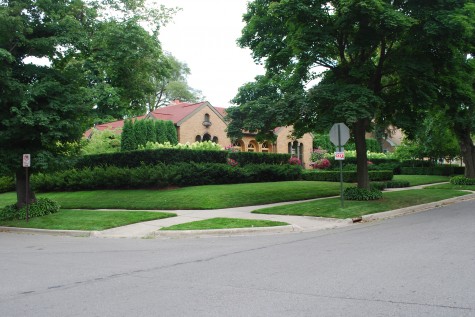 Though I took this picture on a July day last year, in my heart was a big thanks to those impassively dark green evergreens that scooped me up, and made my love of landscape a reality. Most of these plants were planted fifteen years ago. Don’t delay: plan, go so far as to master plan. Plant a few evergreens, or plant lots. Plant little plants or plant a few big ones. Think about where evergreens might provide a focus to a space, screen an untoward view, describe a space, break the wind, provide a beautiful backdrop. Today is the best day of this gardening season to think about putting a plan in place. The evergreens-they can help you.
Though I took this picture on a July day last year, in my heart was a big thanks to those impassively dark green evergreens that scooped me up, and made my love of landscape a reality. Most of these plants were planted fifteen years ago. Don’t delay: plan, go so far as to master plan. Plant a few evergreens, or plant lots. Plant little plants or plant a few big ones. Think about where evergreens might provide a focus to a space, screen an untoward view, describe a space, break the wind, provide a beautiful backdrop. Today is the best day of this gardening season to think about putting a plan in place. The evergreens-they can help you.

